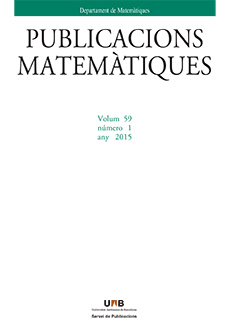Abstract
On a domain $\Omega \subseteq \mathbb{R}^d$ we consider second-order elliptic systems in divergence-form with bounded complex coefficients, realized via a sesquilinear form with domain $\mathrm{H}_0^1(\Omega) \subseteq \mathcal{V} \subseteq \mathrm{H}^1(\Omega)$. Under very mild assumptions on~$\Omega$ and $\mathcal{V}$ we show that the solution to the Kato Square Root Problem for such systems can be deduced from a regularity result for the fractional powers of the negative Laplacian in the same geometric setting. This extends earlier results of McIntosh [25] and Axelsson-Keith-McIntosh [6] to non-smooth coefficients and domains.
Citation
Moritz Egert. Robert Haller-Dintelmann. Patrick Tolksdorf. "The Kato square root problem follows from an extrapolation property of the Laplacian." Publ. Mat. 60 (2) 451 - 483, 2016. https://doi.org/10.5565/PUBLMAT_60216_05
Information





